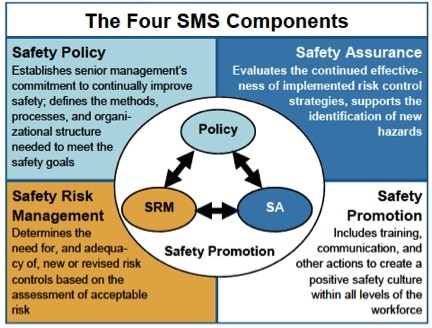How Supply Chain/External Vendors Can Impact Your SMS Performance

For companies that have implemented a Safety Management System, the word “audit” has become an integral part of day-to-day operations. Yet, how many organizations actually examine the safety performance of their vendors and contracted service providers?
Vendor safety performance can directly impact your organization’s safety performance, particularly if associated with critical safety functions. Monitoring your vendors to KPIs suggests you have set them appropriately. In reality, many organizations intend, yet fall short, departing or ‘drifting1’ away from stated objectives.
The most prevalent weaknesses of an organization’s quality and safety system are:
- The inability to identify and evaluate an external service provider (vendor);
- The contract for vendor services; and
- The vendor’s actual performance.
The assumption is that the person or department defining service levels and expected performance (safe facilities, trained workers, functional equipment, etc.) is aware of the organization’s SMS and its governing policies, processes, and risk thresholds. Regrettably, procurement/supply chain personnel are not even aware of the acronym SMS much less the governing policies crafted by your Accountable Executive.
Often, external audits are merely designed to assess the level of compliance to contractual requirements, which may not effectively assess the risk profile of the vendor’s activity. External audits that refer to the contract for services oftent do not include any performance criteria other than service, schedule and price.
Encouraging and educating procurement personnel tasked with contracting external services on the fundamentals of your safety and quality program is a “must do” for your SMS. Requiring your procurement/supply chain program to align with your SMS is critical to assure you are proactively, and, once data is processed, predictively assessing vendor performance. Education of procurement personnel is necessary so they understand what you expect the vendor to provide, the specific standards and the process. One recent operational audit revealed a procurement officer advising, “I just purchase what I am told based on the department that requested it…I assume they did their due diligence.”
Safety assurance is not the only pillar that addresses vendor oversight and performance. Like any new employee or contractor you bring into your organization, vendors and those within your supply chain need to understand your fundamentals. Without it, all of your efforts to protect your organization, people, assets and brand can be compromised. All four SMS components or pillars apply to vendor services and the oversight exercised on them. When was the last time you heard an organization risk-rank a vendor? Are there any contingencies in place in case a vendor turns out to be high risk? Has the organization taken into account the effects of a single source? These are questions that require thoughtful answers.
As mentioned earlier, the notion that your vendors are not keenly aware of your operating fundamentals, which may be communicated via your Safety & Quality Policy (Safety Policy (SP) Pillar), suggests a less than adequate understanding of the purpose of SMS. Likewise, the need to assess the hazards associated with each vendor activity and the resultant risk (Safety Risk Management (SRM) Pillar) to form a baseline risk profile of the vendor, can be continuously evaluated as you incorporate mitigating risk reduction/elimination strategies put in place to accept the vendor.
The reason for this is that SMS, in some organizations, has tended to be a safety department exercise rather than the enterprise-wide, holistic program it was intended to be. There are many reasons for this, the most prevalent being a lack of understanding of the “system” portion of safety management.
For an SMS to be truly effective for the organization it serves, it must throw a wide net to cover all departments that have an effect on performance—from recruitment/human resources and IT to supply chain, operations and strategic planning.
The net I speak of is Safety Promotion, which is equally misunderstood. We focus too much attention on complicating safety management and supporting systems that we lose sight of what is the essence of safety management—education and the relentless promotion of the safety and quality policies and programs (SMS and QMS) so that all work to raise the collective level of awareness of the organization and its suppliers and vendors.
After all, isn’t that what all this is about—raising awareness?
1 S. Snook, Theory of Practical Drift

AvMaSSI provides safety, security and operational integrity evaluations, consulting and auditing to airlines, airports, charter and corporate operators, OEMs, marine operators, seaports, governments, international agencies and financial institutions the world over. AvMaSSI provides IS-BAO and IS-BAH preparation and audit services and supports Global Aerospace and its SM4 and Vista Elite Programs with focused safety/SMS, security, regulatory compliance and IS-BAO auditing services. AvMaSSI is a proud member of the Global Aerospace SM4 partnership program.
http://www.Avmassi.com
© 2025 Aviation & Marine Safety Solutions International. All Rights Reserved.
Next ArticleRelated Posts

Part 108: The Next Step in BVLOS Integration and Drone Innovation
As the drone industry awaits the Federal Aviation Administration’s (FAA) forthcoming Part 108 regulations, the landscape of Beyond Visual Line of Sight (BVLOS) operations stands on the brink of transformation. These anticipated rules aim to standardize BVLOS flights, enabling more complex and expansive drone missions across various sectors.

Giving the Hazard Log the Attention It Deserves
Safety risk profile. Hazard log. Hazard risk register. Whatever you call it internally, one thing is clear: It is a fundamental requirement in your safety management system.


